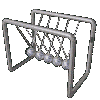CONTENTS
i Preface
ii Acknowledgements
1 The Need to Rewrite History
of Perpetual Motion and Physics
2 Difficulties in Writing
Perpetual Motion History
2.1 Examination
of Claims
3 “PERPETUAL MOTION”
Where Technology Meets Religion.”
Ramananda’s Thoughts on History of Perpetual Motion
4 ORIGINS OF PERPETUAL MOTION
4.1 Roots
of Perpetual Motion in Prehistoric Time
4.2 The
Invention of the Wheel
4.3 Perpetual
Motion in Vedic Times
4.4 Roots
of Perpetual Motion in Religion
Yantras
: Swastika and other Sacred Versions of Wheel
4.5 Cross
4.6 Perpetual
Motion in Mystic Tradition
4.7 Fundamentals
of Qabbalistic Cosmogony
5 MECHANICAL ARTS IN MYTHOLOGY
5.1 Roots
of Perpetual Motion in Mythology
5.2 Vishwakarma,
5.3Hermes
Trismegustus: Thoth
5.4 The
Seven Hermetic Principles
5.5 Adam
and his Arts
5.6 Greek
Mythology
5.7 Prometheus
5.8 Hephaestus
5.9The
Self Wheeling
Tripods Of The Gods
5.10 Athena
/ Minerva
5.11 Hestia
: the Goddess of Architecture
5.12 Daedalus
and Icarus 520 BC
6 ROOTS OF PERPETUAL MOTION
IN MAN’S DREAM OF FLYING
6.1 Flying
Machines in Ancient India
Speculations on the Structure and Mechanism of Flying
6.2 Flying
Machines in Medieval Times
6.3 Strange
Artifacts
6.4 Precolombian
Airplane Models
6.5 Strange
and Wonderful, Huge Stone Balls of Costa Rica!
6.6 Shape,
Speculations about Formation,
6.7 Purpose
Theory
7 PROGRESS OF PERPETUAL MOTION
PARALLELS WITH EVOLUTION OF INTELLIGENCE
7.1 Evolution
of Concepts of Perpetual Motion
7.2 The
Survivalist Systems
7.3 Perpetual
Motion in Middle Ages
8 MAGIC, PERPETUAL MOTION
AND MECHANICAL ARTS IN
GREECE AND ROME
8.1 Magic
in Medieval Times
8.2 Man’s
Dominion over Nature
8.3 Greeks
and their Anti Perpetual Motion Philosophy
8.4 Automatones
(Animate Statues)
i Golden Attendants of Hephaestus
ii Gold & Silver Watchdogs of King Aeetes of Colchis
iii Bronze Bulls of King Aeetes of Colchis
iv Bronze Giant of King Minos of Crete
v Golden Singers of Apollo at Delphi
vi Eagle of Prometheus
vii Heron
of Alexandria
viii Roman
Technology
ix Archimedes
(b c 2 87- 212)
8.5 Greeks
and Their Anti Perpetual Motion Philosophy
8.6 Greek
Astronomy
8.7 Hatred
for Manual Labor
8.8 Further
Development Of The Division Of Labour
8.9 Christian
Attitude towards Technology
8.10 Greek
Contempt for Experimentation
9 THE DEVELOPMENT OF MECHANICAL
ARTS AND PERPETUAL MOTION IN
MIDDLE AGES IN INDIA
9.1 Kautilya’s
‘Arthshastra’ and Status of Mechanical Arts in India
9.2 Siddhantas
9.3 Brahmagupta
(598-668),
9.4 Arab
Connection
9.5 Lallacharya
(720 – 790 A.D.)
9.6 Bhaskaracharya
(1114-1185 AD)
9.7 Perpetual
Motion :A Heritage Of India
9.8 Truth
Of Perpetual Motion
10 PERPETUAL MOTION IN THE WEST
10.1 Alchemy
and Perpetual Motion
10.2 Church
in Middle Ages : Respect to Labor and Dignity
10.3 Islamic
And Arabic Science
10.4 Mechanical
Arts in Middle Ages
10.5 Craftsman
10.6 Forerunners
Of Perpetual Motion
10.7 The
"Scoop wheel" or "Tympanum"
10.8 Noria
10.9 Mechanical
Devices in Arab World
10.10
Watermill
10.11
Clocks
10.12
Water Clocks (Clepsydra)
10.13
Greek and Roman Technology
10.14
Egypt
10.15
Al-Jazari’s Mechanical Devices
10.16
Su Sung’s Water Driven Astronomical Clock
10.17
Wind Mill
10.18
Mechanical Clocks
10.19
Renewal of Interest in Perpetual Motion
10.20
J. N. De La Hire’s Double-Acting Water Pump
10.21
Ewbank's Hydraulics - Wirtz' Pump
11 MAGNETIC PERPETUAL MOTION
11.1 Magnes-
The Herdsman: The Discoverer of Magnet
11.2 Wu
Ching Tsung Yao
11.3 Shen
Kua (1030-93)
11.4 Picard
Petrus Peregrinus’ Magnetic Perpetual Motion 1269
Villard
Honnecarte
Drawings
from the Album of Villard de Honnecourt
Roger
Bacon (1214-1294 or 92)
11 KING BHOJA'S MACHINES, HIS ‘SVAYAMVAHKA’
(PERPETUAL MOTION) & THE THEORY OF ETHER
Violating Law of Conservation of Energy
11.1 Works
of Raja Bhoja
11.2 Samarangana
Sutradhara
11.3 Qualifications
of a “Sthapati”-an Architect
11.4 Raja
Bhoja’s Yantra Shastra
11.5 Definition
of Machine
11.6 Raja Bhoja’s Theory of Vijayad (Ether) - the Ultimate Bija
(Ultimate Source of Power Behind all Motion)
11.7 Prithvi
Yantra (Earth Machine)
11.8 Other
Machines and their Bijas
11.9 Qualities
of Machines and Their Functions (The Karma of Machines)
11.10
Recreational type
11.11
Vari Yantra
11.12
Dhargraha
11.13
Submarines and Ships
11.14
Das Yantra
11.15
Rathadola
11.16
Secrecy
11.17
Warfare Machines
11.18
Flying Aerial Machines
Wooden Birds
11.19 Ambuchari Vimana
11.20
Vaimanika Shastra
11.21
Brief Biography of Paramara king of Dhar Raja Bhoja (1010-53 A.D)
i His
Contributions
ii Bhojeshwar Temple
ii Bhoja Lake
iv Large University in Bhojapura
vi Bhoja's
Military Campaigns
11.22
AUTOMATA
11.23
Technological Diffusion
11.24
Causes of Slow Technological Progress in India
SWAI JAI SINGH’S PERPETUAL MOTION
Samrat
Yantra
Jai Prakasha
Yantra
Rama Yantra
Notes
and References
EEC Series
of Books
Author’s
Introduction

